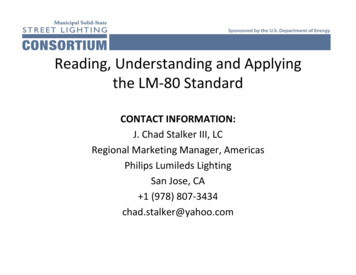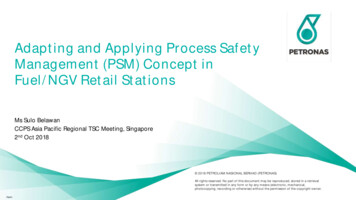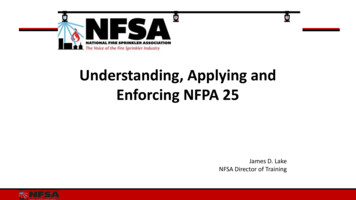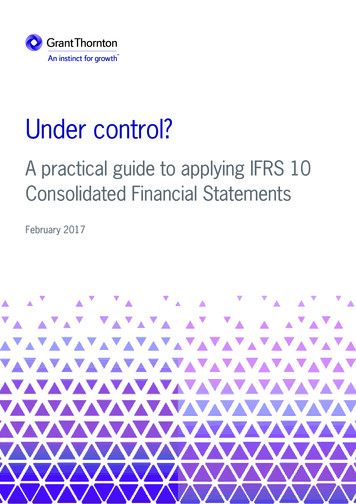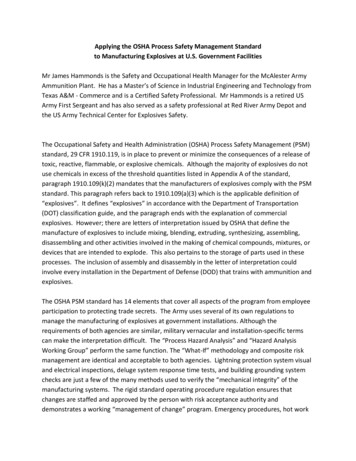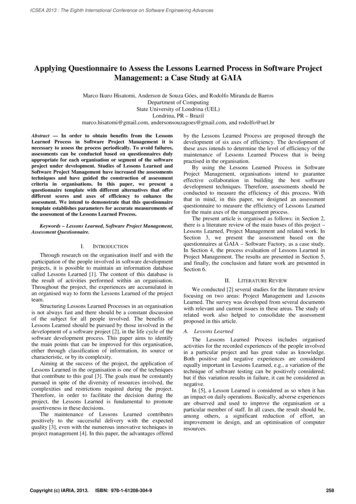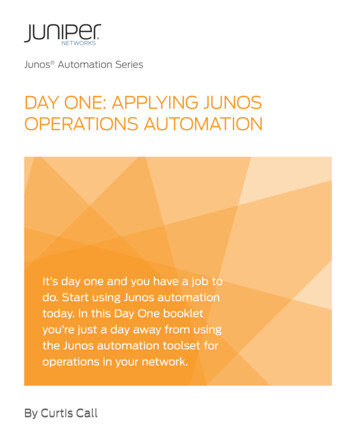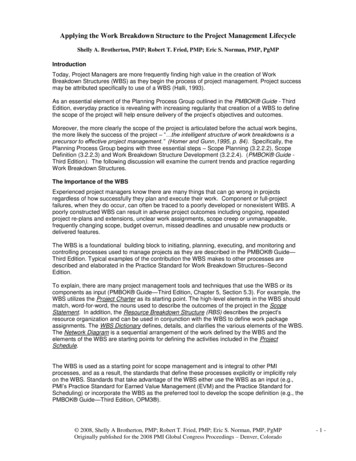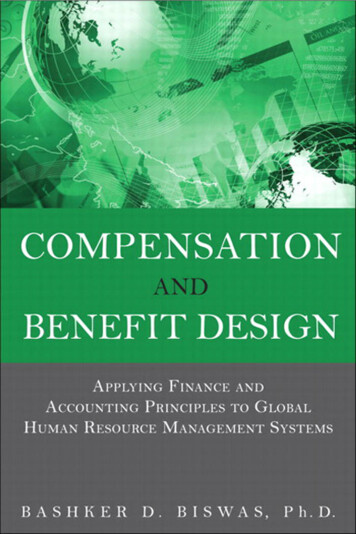
Transcription
COMPENSATIONAND BENEFITDESIGN
This page intentionally left blank
COMPENSATIONAND BENEFITDESIGNApplying Finance and AccountingPrinciples to Global HumanResource Management SystemsBASHKER D. BISWAS
Vice President, Publisher: Tim MooreAssociate Publisher and Director of Marketing: Amy NeidlingerExecutive Editor: Jeanne GlasserEditorial Assistant: Pamela BolandOperations Specialist: Jodi KemperMarketing Manager: Megan GraueCover Designer: Chuti PrasertsithManaging Editor: Kristy HartProject Editor: Elaine WileyCopy Editor: Keith ClineProofreader: Leslie JosephSenior Indexer: Cheryl LenserCompositor: Nonie RatcliffManufacturing Buyer: Dan Uhrig 2013 by Bashker D. BiswasPublishing as FT PressFT Press offers excellent discounts on this book when ordered in quantity for bulkpurchases or special sales. For more information, please contact U.S. Corporate andGovernment Sales, 1-800-382-3419, corpsales@pearsontechgroup.com. For salesoutside the U.S., please contact International Sales at international@pearsoned.com.Company and product names mentioned herein are the trademarks or registeredtrademarks of their respective owners.All rights reserved. No part of this book may be reproduced, in any form or by anymeans, without permission in writing from the publisher.Printed in the United States of AmericaFirst Printing December 2012ISBN-10: 0-13-306478-6ISBN-13: 978-0-13-306478-0Pearson Education LTD.Pearson Education Australia PTY, Limited.Pearson Education Singapore, Pte. Ltd.Pearson Education Asia, Ltd.Pearson Education Canada, Ltd.Pearson Educación de Mexico, S.A. de C.V.Pearson Education—JapanPearson Education Malaysia, Pte. Ltd.Library of Congress Cataloging-in-Publication DataBiswas, Bashker, 1944Compensation and benefit design : applying finance and accounting principles toglobal human resource management systems / Bashkar Biswas.p. cm.Includes bibliographical references and index.ISBN 978-0-13-306478-0 (hardcover : alk. paper) -- ISBN 0-13-306478-61. Wages—United States—Accounting. 2. Compensation management—UnitedStates—Accounting. 3. Employee fringe benefits—United States—Accounting. I. Title.HF5681.W3B57 2013658.3’2--dc232012037322
Dedicated to the memory of my parents and my son.And to a prosperous future for my granddaughter, Mayah.
This page intentionally left blank
ContentsPart 1Chapter 1Introduction: Setting the Stage . . . . . . . . . . . . . . . . . . . . . . .3The Cost Versus Expense Conundrum. . . . . . . . . . . . . . . . . . . 4CAPEX Versus OPEX . . . . . . . . . . . . . . . . . . . . . . . . . . . . . . . . 7The Current HR Cost-Classification Structure . . . . . . . . . . . . 8The Current Accounting for Compensation andBenefit Cost Elements. . . . . . . . . . . . . . . . . . . . . . . . . . . . . 12Key Concepts in This Chapter . . . . . . . . . . . . . . . . . . . . . . . . 23Appendix: The Terms . . . . . . . . . . . . . . . . . . . . . . . . . . . . . . . 24Chapter 2Business, Financial, and Human Resource Planning . . . . . 29The Overall Planning Framework. . . . . . . . . . . . . . . . . . . . . . 30HR Planning. . . . . . . . . . . . . . . . . . . . . . . . . . . . . . . . . . . . . . . 34HR Programs . . . . . . . . . . . . . . . . . . . . . . . . . . . . . . . . . . . . . . 43Key Concepts in This Chapter . . . . . . . . . . . . . . . . . . . . . . . . 52Appendix. . . . . . . . . . . . . . . . . . . . . . . . . . . . . . . . . . . . . . . . . . 53Chapter 3Projecting Base Compensation Costs . . . . . . . . . . . . . . . . .55Base Salary Costs . . . . . . . . . . . . . . . . . . . . . . . . . . . . . . . . . . . 58Key Concepts in This Chapter . . . . . . . . . . . . . . . . . . . . . . . . 67Appendix: Cash Flow Impact of Salary Increases . . . . . . . . . 67Chapter 4Incentive Compensation . . . . . . . . . . . . . . . . . . . . . . . . . . .71An Introduction to Incentive Compensation Programs . . . . . 71Accounting for Annual Cash Incentive Plans . . . . . . . . . . . . . 74Key Incentive Compensation Metrics. . . . . . . . . . . . . . . . . . . 77Free Cash Flow as an Incentive Plan Metric . . . . . . . . . . . . . 81Economic Value Added as an Incentive Plan Metric. . . . . . . 82Residual Income as an Incentive CompensationPlan Metric. . . . . . . . . . . . . . . . . . . . . . . . . . . . . . . . . . . . . . 86The Balanced Scorecard and Incentive Compensation . . . . . 87Balanced Scorecard and Compensation . . . . . . . . . . . . . . . . . 92Key Concepts in This Chapter . . . . . . . . . . . . . . . . . . . . . . . . 94
viiiCOMPENSATION AND BENEFIT DESIGNChapter 5Share-Based Compensation Plans . . . . . . . . . . . . . . . . . . . .95Stock Award Plans . . . . . . . . . . . . . . . . . . . . . . . . . . . . . . . . . . 97Stock Option Plans. . . . . . . . . . . . . . . . . . . . . . . . . . . . . . . . . 100Stock Option Expensing . . . . . . . . . . . . . . . . . . . . . . . . . . . . 103The Accounting for Stock Options . . . . . . . . . . . . . . . . . . . . 106Tax Implications of Stock Plans. . . . . . . . . . . . . . . . . . . . . . . 112International Tax Implications of Share-BasedEmployee Compensation Plans. . . . . . . . . . . . . . . . . . . . . 116Employee Share Purchase Plans . . . . . . . . . . . . . . . . . . . . . . 121Stock Appreciation Rights . . . . . . . . . . . . . . . . . . . . . . . . . . . 122Key Concepts in This Chapter . . . . . . . . . . . . . . . . . . . . . . . 126Appendix: Stock Options and Earnings per Share . . . . . . . . 127Chapter 6International and Expatriate Compensation . . . . . . . . . . .131The Background to International and ExpatriateCompensation . . . . . . . . . . . . . . . . . . . . . . . . . . . . . . . . . . 132The Balance Sheet System . . . . . . . . . . . . . . . . . . . . . . . . . . 136Expatriate Taxes. . . . . . . . . . . . . . . . . . . . . . . . . . . . . . . . . . . 143The Cost-Differential Allowance . . . . . . . . . . . . . . . . . . . . . 151Global Payroll Systems . . . . . . . . . . . . . . . . . . . . . . . . . . . . . 156International Pensions . . . . . . . . . . . . . . . . . . . . . . . . . . . . . . 159Global Stock Option Plans. . . . . . . . . . . . . . . . . . . . . . . . . . . 161Key Concepts in This Chapter . . . . . . . . . . . . . . . . . . . . . . . 164Chapter 7Sales Compensation Accounting . . . . . . . . . . . . . . . . . . . .165General Accounting Practices . . . . . . . . . . . . . . . . . . . . . . . . 166Sales Compensation Plans . . . . . . . . . . . . . . . . . . . . . . . . . . . 168Accounting Control and Audit Issues . . . . . . . . . . . . . . . . . . 175Other Salient Elements of a Sales Compensation Plan . . . . 177Travel Allowances . . . . . . . . . . . . . . . . . . . . . . . . . . . . . . . . . 179Commission Accounting . . . . . . . . . . . . . . . . . . . . . . . . . . . . 183Key Concepts in This Chapter . . . . . . . . . . . . . . . . . . . . . . . 185Chapter 8Employee Benefit Accounting . . . . . . . . . . . . . . . . . . . . . .187The Standards Framework . . . . . . . . . . . . . . . . . . . . . . . . . . 189Defined Contribution Versus Defined Benefit Plans . . . . . 190Section 965 Explained . . . . . . . . . . . . . . . . . . . . . . . . . . . . . . 191
CONTENTSixCalculating Plan Benefit Obligations . . . . . . . . . . . . . . . . . . 194Claims Incurred but Not Reported (IBNR). . . . . . . . . . . . . 194Other Benefit Obligations . . . . . . . . . . . . . . . . . . . . . . . . . . . 196Additional Obligations for PostretirementHealth Plans . . . . . . . . . . . . . . . . . . . . . . . . . . . . . . . . . . . . 197Self-Funding of Health Benefits . . . . . . . . . . . . . . . . . . . . . . 198International Financial Reporting Standards andEmployee Health and Welfare Plans . . . . . . . . . . . . . . . . 201The Financial Reporting of Employee Benefit Plans. . . . . . 202Key Concepts in This Chapter . . . . . . . . . . . . . . . . . . . . . . . 207Chapter 9Healthcare Benefits Cost Management. . . . . . . . . . . . . . .209The Background. . . . . . . . . . . . . . . . . . . . . . . . . . . . . . . . . . . 209The Reasons for the Rising Costs . . . . . . . . . . . . . . . . . . . . . 212Cost Containment Alternatives . . . . . . . . . . . . . . . . . . . . . . . 214Forecasting Healthcare Benefit Costs . . . . . . . . . . . . . . . . . 228Key Concepts in This Chapter . . . . . . . . . . . . . . . . . . . . . . . 230Chapter 10The Accounting and Financing of Retirement Plans . . . .231The Background. . . . . . . . . . . . . . . . . . . . . . . . . . . . . . . . . . . 232The Accounting of the Plans . . . . . . . . . . . . . . . . . . . . . . . . . 235The Pension Benefit Obligation . . . . . . . . . . . . . . . . . . . . . . 245Pension Plan Assets . . . . . . . . . . . . . . . . . . . . . . . . . . . . . . . . 253The Pension Expense. . . . . . . . . . . . . . . . . . . . . . . . . . . . . . . 256The Accounting Record-Keeping . . . . . . . . . . . . . . . . . . . . . 262Accounting Standards Affecting Pension Plans . . . . . . . . . . 265Key Concepts in This Chapter . . . . . . . . . . . . . . . . . . . . . . . 266Part 2Chapter 11Human Resource Analytics . . . . . . . . . . . . . . . . . . . . . . . .271The Background for the Use of HR Analytics . . . . . . . . . . . 272The Need for HR Analytics . . . . . . . . . . . . . . . . . . . . . . . . . . 273Measuring the Effectiveness of HR Investments. . . . . . . . . 274Total Compensation Effectiveness Metrics . . . . . . . . . . . . . 280A Changed Paradigm . . . . . . . . . . . . . . . . . . . . . . . . . . . . . . . 284Key Concepts in This Chapter . . . . . . . . . . . . . . . . . . . . . . . 285
xCOMPENSATION AND BENEFIT DESIGNChapter 12Human Resource Accounting . . . . . . . . . . . . . . . . . . . . . .287The Background. . . . . . . . . . . . . . . . . . . . . . . . . . . . . . . . . . . 287The Debate . . . . . . . . . . . . . . . . . . . . . . . . . . . . . . . . . . . . . . 289HR Accounting Methods. . . . . . . . . . . . . . . . . . . . . . . . . . . . 291Key Concepts in This Chapter . . . . . . . . . . . . . . . . . . . . . . . 300Appendix: No Long-Term Savings fromWorkforce Reductions . . . . . . . . . . . . . . . . . . . . . . . . . . . . 301Conclusion . . . . . . . . . . . . . . . . . . . . . . . . . . . . . . . . . . . . .305An HR Finance and Accounting Audit . . . . . . . . . . . . . . . . . 306References . . . . . . . . . . . . . . . . . . . . . . . . . . . . . . . . . . . . .309Index . . . . . . . . . . . . . . . . . . . . . . . . . . . . . . . . . . . . . . . . . .323
ForewordBashker Biswas and I have known one another for over 40 years.We first met when he joined the corporate compensation and benefits practice at Control Data Corporation as a new college hire. Several years later we met again at Skopos Corporation, where he ledthe compensation practice for this computer-based human resourcesapplication start-up. About five years ago, he joined me at Zain asthe director of the Corporate Total Rewards function. Zain is a multinational corporation based in the Middle East. In between, Biswasworked at Coopers & Lybrand and PricewaterhouseCoopers as aDirector and a Senior Consultant in compensation and benefitsdesign. He also managed to sandwich a parallel career as a collegelevel professor at various universities in the greater San Francisco Bayarea since 1984.Over these years, I have witnessed first hand Biswas’ vast knowledge and repertoire of compensation and benefit design skills, at thenational and international level. It is, therefore, a great honor forme to contribute this foreword and to share with the reader my owninsights and appreciation for Biswas’ contributions to the advancement of the practice of compensation and benefits design.For most firms, people costs are the lion share of both direct andindirect expenses. Managing it requires sound accounting, financialmanagement, and good business judgment. Biswas makes an excellent case for extending the HR skill set to include accounting, finance,and business management. I support the extension of the HR professional role from a technician’s point of view to a business professional.As in most fields, there is art and science involved in HR. It has beensaid that within the classical HR functions, employee relations has themost art and the least science while compensation and benefits hasmore science than art. The book does a great job of capturing the science of compensation and benefit design.Traditional human resources management has taught us thatsound compensation and benefit programs ought to meet threeimportant tests: (1) is it competitive? (2) is it fair?, and (3) is it consistent? Biswas has extended these tests by two additional measures: (1)
xiiCOMPENSATION AND BENEFIT DESIGNis it based on sound accounting and financial management principles?and (2) does it advance the firm’s competitive advantage by makingthe programs commensurate with an organization’s financial objectives? These latter measures make the book seminal and a must-readby students of the HR professional.While traditional human resources management emphasized theimportance of evaluating compensation and benefit programs basedon their ability to attract, motivate, and retain superior human talent,the contemporary view expressed by Biswas is that they also need tobe supported by sound accounting, financial, and business practice.In the past 25 years, it has become fashionable for HR professionals todescribe their role as business partners. In my view, HR professionalscan rightfully claim that title only when bestowed on them by theirhost organization. Senior management will recognize HR professionals as partners only when they demonstrate a working knowledge ofthe organization’s financial and business imperatives and demonstratethe ability to link HR programs to the accounting, financial, and business results of the firm. Until then, the term, to many, has little or novalue.As competition worldwide continues to grow, finding, honing, andretaining a competitive advantage is becoming more and more elusive. Experience teaches us that HR has a great opportunity to contribute to this endeavor. How? If your firm has a more cost-effectivecompensation and benefits program, by definition, it has an economicadvantage over less cost-effective firms. If your firm has a compensation program better tailored to advance the firm’s objectives, again bydefinition, it has an operational advantage over firms that are unableto focus people’s efforts. If your firm is more able to link rewards withboth individual and organizational financial performance, by definition, it has an employee relations advantage over firms that are unableto pay for performance.It is fashionable to hire compensation consultants from wellknown consulting firms to come in and do the compensation and benefit design work. My experience has taught me that what you willget, at best, is a good boiler-plate solution, and at worst, a flavor ofthe year, gimmicky proposal. External consultants, for all their technical knowledge, do not have an intimate knowledge of your firm, its
FOREWORDxiiiaspirations, foibles, and driving force. They also often provide solutions that are difficult to implement or expensive to maintain, making the need for their service a never-ending dependency. Thus itbecomes imperative for HR professionals to develop their financeand accounting skills. This book will help with that effort.Finally, Biswas’ book reinforces the importance of custom design.Every firm is unique! There are no two firms alike. Designing onesize-fits-all compensation and benefit programs to match current fadsor what is in vogue is foolhardy. His repertoire of design options isintended to promote the notion of linking compensation and benefitprograms to the unique needs of the organization, from the accounting and financial perspectives. Biswas’ work links design options witha number of critical legal requirements.Tony Tasca, Ph.D.Retired HR Executive & International ConsultantPalo Alto, CaliforniaDecember 2012
AcknowledgmentsThis book would not have been possible without the efforts ofmy colleagues at DeVry University–Keller School of Management,Sacramento Campus, where I currently teach as a visiting professor.A special thanks goes to Oscar Gutierrez, national dean, College ofBusiness and Management, for introducing this publishing opportunity to the faculty. To Dr. Jose Michel goes much appreciation forfacilitating the project. And to Mary Cole MS, MAFM, Professor andBusiness Manager, for so willingly approving the student support forthe project and for facilitating my ongoing teaching career. Also, Iwant to thank my many students who have helped me in various ways,throughout the years, to improve the clarity of my thinking.A special word of appreciation goes to Dr. Anythony Tasca forwriting the foreword to the book. I have known Tony for 42 years. Heknows the art and the science of Human Capital Management, havingserved as a Chief Human Resource Officer of a very large company,and also having been a distinguished Human Capital EffectivenessManagement Consultant to many companies over a period of 38 years.This project greatly benefited from the efforts of Nusrat Tinni,one of my hardworking graduate accounting students at Keller Schoolof Management, who carried the burden of transcribing the manuscript. Occasionally, I received some research assistance from anotherbrilliant student, Madison Voss. I also want to acknowledge the workof Sharon Evers, who provided additional valuable transcriptionsupport.My appreciation goes to Jeanne Glasser Levine, executive editorat FT Press, for so ably guiding this project to completion. Here also,I wish to acknowledge the assistance I received from Project EditorElaine Wiley and Copy Editor Keith Cline. They both were calm, collected, and competent. They are true human resource assets to theirorganization.I want to especially thank and acknowledge Thomas Hestwood,my friend and colleague of many years. Our joint research and publishing efforts have found expression in two of the chapters in thisbook. Tom was a strong professional partner early in my career. Our
ACKNOWLEDGMENTSxvconnections have remained steadfast over the many years. I owe adeep gratitude to Tom for agreeing so readily to the use of two of ourjoint publications in this book.Finally, and as always, I acknowledge the efforts of my wife ofmore than 40 years, Usha, who has steadfastly provided support forthis project and for many others. On this project, her assistance wasinvaluable both with the administrative tasks and in the editing of themanuscript.Bashker Biswas, Ph.D.Lincoln, CaliforniaAugust 2012
About the AuthorBashker “Bob” Biswas, Ph.D., is the Principal of the BiswasGroup Inc., a Global Management Consultancy. Dr. Biswas concurrently holds the position of Visiting Professor at Keller School of Management at DeVry University in Sacramento, California.Dr. Biswas has over 40 years experience in Total Rewards Management; Finance; Accounting; Executive Compensation; Base,Incentive, Sales and Equity Compensation; Human Resource Strategy; Human Resource Information Systems; International HumanResources; and International Compensation.The companies he has worked for are Control Data, Bechtel,Memorex, Maxtor, Hitachi Data Systems and BioGenex, and Zain.Dr. Biswas has held positions at the Director level and above since1982. At Maxtor and BioGenex he was a Vice President. While atMemorex and Zain, he worked out of London and the Middle East/Africa respectively. He has traveled to over 30 countries on variouscompensation and benefits related projects.During his tenure in the Middle East, Dr. Biswas conductedTotal Rewards and Global Human Resource Management Seminarsthroughout the Middle East and Africa. He was a leading instructorin the Zain Human Resource Management Academy.In addition, he has held consulting positions at Skopos Cor
Aug 01, 2005 · management, and good business judgment. Biswas makes an excel-lent case for extending the HR skill set to include accounting, finance, and business management. I support the extension of the HR profes-sional role from a technician’s point of view to a business professional. As in most fie

